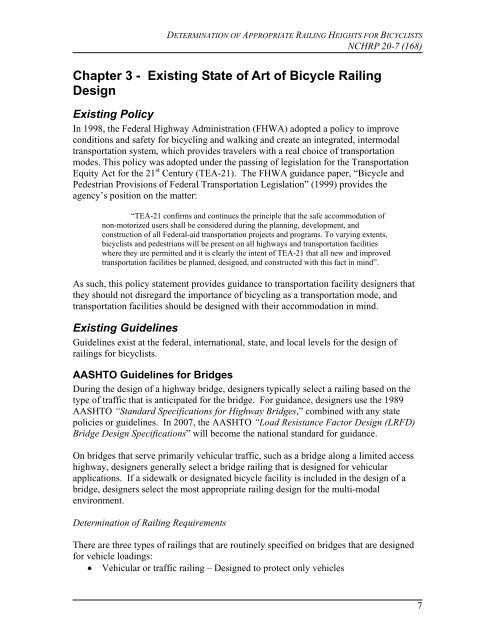Bicycle Railing Height Report - AASHTO - Subcommittee on Design
Bicycle Railing Height Report - AASHTO - Subcommittee on Design
Bicycle Railing Height Report - AASHTO - Subcommittee on Design
Create successful ePaper yourself
Turn your PDF publications into a flip-book with our unique Google optimized e-Paper software.
DETERMINATION OF APPROPRIATE RAILING HEIGHTS FOR BICYCLISTS<br />
NCHRP 20-7 (168)<br />
Chapter 3 - Existing State of Art of <str<strong>on</strong>g>Bicycle</str<strong>on</strong>g> <str<strong>on</strong>g>Railing</str<strong>on</strong>g><br />
<strong>Design</strong><br />
Existing Policy<br />
In 1998, the Federal Highway Administrati<strong>on</strong> (FHWA) adopted a policy to improve<br />
c<strong>on</strong>diti<strong>on</strong>s and safety for bicycling and walking and create an integrated, intermodal<br />
transportati<strong>on</strong> system, which provides travelers with a real choice of transportati<strong>on</strong><br />
modes. This policy was adopted under the passing of legislati<strong>on</strong> for the Transportati<strong>on</strong><br />
Equity Act for the 21 st Century (TEA-21). The FHWA guidance paper, “<str<strong>on</strong>g>Bicycle</str<strong>on</strong>g> and<br />
Pedestrian Provisi<strong>on</strong>s of Federal Transportati<strong>on</strong> Legislati<strong>on</strong>” (1999) provides the<br />
agency’s positi<strong>on</strong> <strong>on</strong> the matter:<br />
“TEA-21 c<strong>on</strong>firms and c<strong>on</strong>tinues the principle that the safe accommodati<strong>on</strong> of<br />
n<strong>on</strong>-motorized users shall be c<strong>on</strong>sidered during the planning, development, and<br />
c<strong>on</strong>structi<strong>on</strong> of all Federal-aid transportati<strong>on</strong> projects and programs. To varying extents,<br />
bicyclists and pedestrians will be present <strong>on</strong> all highways and transportati<strong>on</strong> facilities<br />
where they are permitted and it is clearly the intent of TEA-21 that all new and improved<br />
transportati<strong>on</strong> facilities be planned, designed, and c<strong>on</strong>structed with this fact in mind”.<br />
As such, this policy statement provides guidance to transportati<strong>on</strong> facility designers that<br />
they should not disregard the importance of bicycling as a transportati<strong>on</strong> mode, and<br />
transportati<strong>on</strong> facilities should be designed with their accommodati<strong>on</strong> in mind.<br />
Existing Guidelines<br />
Guidelines exist at the federal, internati<strong>on</strong>al, state, and local levels for the design of<br />
railings for bicyclists.<br />
<str<strong>on</strong>g>AASHTO</str<strong>on</strong>g> Guidelines for Bridges<br />
During the design of a highway bridge, designers typically select a railing based <strong>on</strong> the<br />
type of traffic that is anticipated for the bridge. For guidance, designers use the 1989<br />
<str<strong>on</strong>g>AASHTO</str<strong>on</strong>g> “Standard Specificati<strong>on</strong>s for Highway Bridges,” combined with any state<br />
policies or guidelines. In 2007, the <str<strong>on</strong>g>AASHTO</str<strong>on</strong>g> “Load Resistance Factor <strong>Design</strong> (LRFD)<br />
Bridge <strong>Design</strong> Specificati<strong>on</strong>s” will become the nati<strong>on</strong>al standard for guidance.<br />
On bridges that serve primarily vehicular traffic, such as a bridge al<strong>on</strong>g a limited access<br />
highway, designers generally select a bridge railing that is designed for vehicular<br />
applicati<strong>on</strong>s. If a sidewalk or designated bicycle facility is included in the design of a<br />
bridge, designers select the most appropriate railing design for the multi-modal<br />
envir<strong>on</strong>ment.<br />
Determinati<strong>on</strong> of <str<strong>on</strong>g>Railing</str<strong>on</strong>g> Requirements<br />
There are three types of railings that are routinely specified <strong>on</strong> bridges that are designed<br />
for vehicle loadings:<br />
• Vehicular or traffic railing – <strong>Design</strong>ed to protect <strong>on</strong>ly vehicles<br />
7


